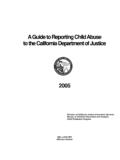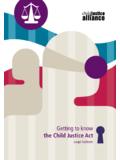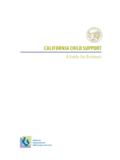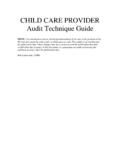Transcription of CHILD PROTECTION POLICIES AND PROCEDURES TOOLKIT …
1 CHILD PROTECTION . POLICIES AND. PROCEDURES . TOOLKIT . (c) 2005 Elanor Jackson and Marie Wernham and ChildHope All rights reserved ChildHope 6th Floor, Development House 56 - 64 Leonard Street London EC2A 4JX. general email: This publication may be reproduced, as a whole or in part, provided that acknowledgement of the source is made. Notification of such would be appreciated. ISBN: 0-9547886-1-3. Published by: Consortium for Street Children Unit 306, Bon March Centre, 241-251 Ferndale Road, London SW9 8BJ, UK. March 2005. Authors: Elanor Jackson, Marie Wernham Design, layout and printing: Greenhouse Print and Design, London Cover Photographs: Elanor Jackson ChildHope is grateful to the Big Lottery Fund for their financial support of this TOOLKIT . CHILD PROTECTION . POLICIES AND. PROCEDURES . TOOLKIT . HOW TO CREATE A CHILD -SAFE ORGANISATION. Elanor Jackson ChildHope UK. Marie Wernham Consortium for Street Children UK.
2 Produced by ChildHope UK. Published by Consortium for Street Children CONTENTS. Foreword 08. Acknowledgements 08. Glossary / Definitions 09. Introduction 10. Structure 11. User Guide 13. STAGE 1 INTRODUCING CHILD PROTECTION 17. ) What is CHILD PROTECTION / What is a CHILD PROTECTION policy? ) What is CHILD abuse? ) Why do we need CHILD PROTECTION POLICIES and PROCEDURES ? STAGE 2 THE NECESSARY FOUNDATIONS 39. ) Introduction to the 6 foundation stones ) The 6 foundation stones in more detail STAGE 3 DEVELOPING A CHILD PROTECTION POLICY AND PROCEDURES 53. ) Introducing the 7 elements of a CHILD PROTECTION policy and PROCEDURES ) The 7 elements of a CHILD PROTECTION policy and PROCEDURES in detail ) How to decide on which elements to include in a CHILD PROTECTION policy and PROCEDURES ) What does your organisation currently have in place? STAGE 4 IMPLEMENTING CHILD PROTECTION POLICIES AND PROCEDURES 83.
3 Putting POLICIES and PROCEDURES into action ) CHILD PROTECTION in practice responding to situations STAGE 5 DEALING WITH OBSTACLES AND CHALLENGES 101. STAGE 6 MONITORING AND EVALUATING CHILD PROTECTION POLICIES AND PROCEDURES 107. The best way to protect children is to empower them to protect themselves 05. Appendices APPENDIX 1: Recognising signs of abuse 116. APPENDIX 2: Participation of children in developing, implementing and monitoring CHILD PROTECTION POLICIES and PROCEDURES 118. APPENDIX 3: Dealing with sensitivities about CHILD abuse 123. APPENDIX 4: Examples of behaviour guidelines 124. APPENDIX 5: Alternative forms of discipline 127. APPENDIX 6: Anti-bullying policy, ChildHope 134. APPENDIX 7: Examples of guidelines on communications about children 138. APPENDIX 8: Participatory facilitation 141. APPENDIX 9: Guidelines on recruitment 144. APPENDIX 10: Education and training (Training Needs Analysis Worksheet) 147.
4 APPENDIX 11: Allegations from a CHILD listening to a CHILD 's disclosure of abuse 149. APPENDIX 12: Reporting and reaction protocol: Recommended guidelines 150. APPENDIX 13: Sample report form for suspected abuse 152. APPENDIX 14: Ramifications of misconduct 154. APPENDIX 15: Tips for overall impact assessment in monitoring and evaluation 155. APPENDIX 16: Sample of a detailed monitoring and evaluation framework for CHILD PROTECTION POLICIES and PROCEDURES 157. APPENDIX 17: Statement of commitment 158. APPENDIX 18: Examples of obstacles and solutions to implementing CHILD PROTECTION POLICIES and PROCEDURES from CSC members workshop, October 2003 159. APPENDIX 19: ChildHope self-audit tool 162. APPENDIX 20: CHILD PROTECTION for disabled children 166. APPENDIX 21: CHILD abuse case studies newspaper articles 170. APPENDIX 22: Sample guidelines for CHILD sponsorship 174. APPENDIX 23: Selected articles from the UN Convention on the Rights of the CHILD 176.
5 APPENDIX 24: Core CHILD PROTECTION principles and values 178. APPENDIX 25: CHILD PROTECTION children's drawing used in Exercise 4 179. APPENDIX 26: 3-Day training schedule for training course on developing and implementing CHILD PROTECTION POLICIES and PROCEDURES 181. APPENDIX 27: Quiz for use in training course 184. APPENDIX 28: Course evaluation form 185. APPENDIX 29: Snakes and ladders' game 187. APPENDIX 30: References / further reading 189. 06 The best way to protect children is to empower them to protect themselves Exercises EXERCISE 1: What are we protecting children from?' - Stage 1, Section 22. EXERCISE 2: Abuse or not abuse?' - Stage 1, Section 26. EXERCISE 3: True or false? Attitudes towards CHILD PROTECTION POLICIES and PROCEDURES ' - Stage 1, Section 31. EXERCISE 4: Case studies / scenarios on CHILD PROTECTION : What would you do if ?' - Stage 1, 32. Section EXERCISE 5: Risk analysis - Stage 1, Section 34.
6 EXERCISE 6: Confidentiality - Stage 2, Section 51. EXERCISE 7: Chinese whispers' - Stage 2, Section 51. EXERCISE 8: Stakeholder mapping - Stage 3, Section 67. EXERCISE 9: Stakeholder ranking - Stage 3, Section 68. EXERCISE 10: Which elements are essential' and which are desirable'? Facilitating participatory discussions - Stage 3, Section 69. EXERCISE 11: The pros and cons of different approaches to introducing a CHILD PROTECTION policy in your organisation - Stage 3, Section 76. EXERCISE 12: Self-audit exercise - Stage 3, Section 80. EXERCISE 13: Developing an organisational action plan - Stage 4, Section 91. EXERCISE 14: Possible situations: responding to allegations or concerns - Stage 4, Section 95. EXERCISE 15: Case study: (Chisomo, Malawi) The Truth at any Cost' - Stage 4, Section 97. EXERCISE 16: Identifying obstacles and solutions - Stage 5 105. EXERCISE 17: Building monitoring and evaluation into the organisational action plan - Stage 6 112.
7 The best way to protect children is to empower them to protect themselves 07. Foreword This TOOLKIT has been produced by ChildHope as a practical learning tool and set of resources for non-governmental / civil society organisations, in particular those in developing countries, working with children. The tools and techniques included here could also be applied, however, to private / commercial and government sector organisations. The TOOLKIT outlines and explores some of the key principles and issues relevant to CHILD PROTECTION , as well as outlining the steps that are needed in order to develop, implement, monitor and evaluate CHILD PROTECTION POLICIES and PROCEDURES . The tools can be used by those with overall executive responsibility for an organisation or by a designated person or group within the organisation with responsibility for CHILD PROTECTION issues. The TOOLKIT also serves as background reading on CHILD PROTECTION POLICIES and PROCEDURES for those who will be involved in developing POLICIES and PROCEDURES and their implementation.
8 The exercises have been designed as a learning and reference tool and there are a number of appendices which will serve as further reference tools providing detailed information and guidelines. As with all learning materials, the information and materials provided in this TOOLKIT will be most effective when adapted and applied to meet specific needs. A training course supports this TOOLKIT and has been designed to fit alongside other ChildHope courses so that a comprehensive and coherent personal or staff development programme can be planned avoiding repetition or contradiction between individual modules. We hope that you find this TOOLKIT useful and enjoy any associated training experiences with ChildHope. Acknowledgements The authors would like to thank the following organisations and individuals: Paul Nolan and the Save the Children Fund UK, Chris Beddoe, ECPAT UK, ECPAT Australia, International HIV/AIDS Alliance, Jenny Myers and the National Society for the Prevention of Cruelty to Children (NSPCC), TearFund, World Vision UK, Sense International, Terre des Hommes, Anita Schrader and International Children's Trust, Cathy James and Chisomo, CINI ASHA, SEED, PBKOJP, OFFER, Sabuj Sangha, Mkombozi, JUCONI Mexico, Instituto PROMUNDO, Steve Waller, Methodist Church, David Maidment, Mike Northcroft and Tarah Minchin, ChildHope, Andres Gomes Torres, Robin Jackson.
9 Phil Ayers of Greenhouse Print and Design, Greenhouse Printers and Clare Turner. Simon Grosser for his work on the CD-Rom. The Staff of ChildHope and the Consortium for Street Children. 08 The best way to protect children is to empower them to protect themselves Glossary / Definitions CHILD . For the purposes of this document, a CHILD is defined as anyone under the age of 18, in line with the UN. Convention on the Rights of the CHILD . CHILD ABUSE. According to the World Health Organisation, CHILD abuse or maltreatment constitutes all forms of physical and/or emotional ill-treatment, sexual abuse, neglect or negligent treatment or commercial or other exploitation, resulting in actual or potential harm to the CHILD 's health, survival, development or dignity in the context of a relationship of responsibility, trust or power.'1. CHILD PARTICIPATION. Anyone below the age of 18 taking part in a process or playing a role in a process at his/her level, according to their evolving capacities - children and young people thinking for themselves, expressing their views effectively, and interacting in a positive way with other people; involving children in the decisions which affect their lives, the lives of the community and the larger society in which they CHILD PROTECTION .
10 A broad term to describe philosophies, POLICIES , standards, guidelines and PROCEDURES to protect children from both intentional and unintentional harm. In the current context, it applies particularly to the duty of organisations - and individuals associated with those organisations - towards children in their care. DIRECT CONTACT WITH CHILDREN. Being in the physical presence of a CHILD or children in the context of the organisation's work, whether contact is occasional or regular, short or long term. INDIRECT CONTACT WITH CHILDREN. Having access to information on children in the context of the organisation's work, such as children's names, locations (addresses of individuals or projects), photographs and case studies. Providing funding for organisations that work directly' with children. Albeit indirectly, this nonetheless has an impact on children, and therefore confers upon the donor organisation responsibility for CHILD PROTECTION issues.















